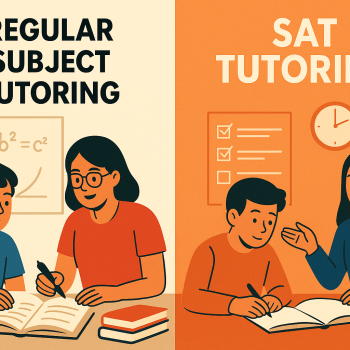When Practice Backfires: Why More Isn’t Always Better on the Digital SAT
You’ve probably heard the golden rule: practice makes perfect. For the Digital SAT, that advice is generally true — but only up to a point. Once you push past effective practice, you can trigger a set of sneaky, demoralizing problems: burnout, diminishing returns, shallow learning, and even habits that hurt your test-day performance. This post walks through the most common pitfalls students stumble into when they over-practice, explains why they happen, and gives clear, human solutions you can use right away. I’ll also note how targeted one-on-one help—like Sparkl’s personalized tutoring, tailored study plans, and AI-driven insights—can rescue you from a practice rut when it’s time for smarter, not harder, work.
What “Over-Practicing” Really Looks Like
Over-practicing isn’t just about the number of hours. It’s a pattern that combines quantity with poor quality or poor strategy. Here are the most common flavors:
- Endless full-length tests without reflection (quantity over analysis).
- Repeating the same problem types until you become automatic but shallow.
- Practicing in a distracted environment or at the wrong time of day.
- Hitting a plateau and doubling down on the same methods instead of changing approach.
- Neglecting sleep, nutrition, and mental recovery because “I need one more practice test.”
Why this matters for the Digital SAT
The Digital SAT is shorter and adaptive in sections, meaning small changes in strategy and mental state can have outsized effects. The test also runs on devices via Bluebook-style platforms where navigation, time perception, and screen-based reading skills matter. When practice ignores these specifics and becomes rote repetition, you can accidentally train the wrong muscles.
Pitfall 1: Mindless Volume — Doing Practice Tests Like a Machine
It’s tempting to think that if four tests are good, eight must be twice as good. Students who fall into this trap often treat practice tests as score-generators rather than learning opportunities.
Symptoms
- Scores bounce all over — sometimes up, sometimes down — with no clear pattern.
- Little to no improvement on weak question types despite many repetitions.
- Stress rises before test day even though you “practiced a lot.”
Why it happens
Repeating full-length tests without post-test analysis creates shallow familiarity. You become practiced at taking a test, not at mastering the underlying skills. In adaptive sections, this is especially damaging: the algorithm responds to your performance, so simply repeating a test without addressing the weak zones doesn’t produce predictable improvement.
How to fix it
- Swap one full-length practice test for two targeted study sessions: one focused on concept review, one on strategy drills.
- After every practice test, spend double the test duration reviewing: identify 3 patterns in your mistakes and make a 1-week mini-plan to fix them.
- Use deliberate practice: set tiny, measurable goals for each session (e.g., “improve sentence correction accuracy by 10% on pronoun agreement items”).
Pitfall 2: Repetition Without Variation — Training to Fail a Different Way
Doing the same style of practice over and over is like running sprints when your marathon pace matters: you get better at sprints and worse at pacing. Students often rotate the same problem sources, formats, or time constraints and then wonder why they can’t transfer skills to the real test.
Symptoms
- You ace practice items from certain sources but freeze on official practice material or on test day.
- You can solve problems when unlimited time is available but crumble under real time pressure.
Why it happens
The Digital SAT uses adaptive behavior and modern item types. If your practice is homogeneous — same question bank, same pacing, same mental state — you aren’t training adaptability. Transfer of learning requires variation: different problem phrasings, variable time windows, and practice on digital platforms that mimic the test interface.
How to fix it
- Mix sources: combine official digital practice with other rigorous problems, but always finish practice cycles with official Bluebook-format items.
- Change conditions: alternate timed 30–45 minute drills, untimed deep-work sessions, and mixed-question mini-tests that force you to switch modes.
- Simulate test environment sometimes: quiet room, device-only, set-up your Bluebook practice environment so that on test day the experience is familiar.
Pitfall 3: Skipping the Root Cause — Treating Symptoms Instead of Problems
When a student keeps missing algebra word problems or evidence-based reading questions, the impulse is to do more of them. That may help, but if you ignore the root cause — weak algebra basics, shaky paragraph mapping strategies, poor attention to question stems — the extra practice is wasteful.
Symptoms
- Persistent errors clustered around a narrow set of underlying issues.
- Frustration and confusion despite hours of practice on the same topic.
Why it happens
Practice can be a blunt instrument. Without diagnostic analysis, you may repeat the same mistake because you haven’t identified the rule or misconception that’s causing it. For example, confusing “mean” and “median,” misreading conditional language in reading passages, or not knowing a core algebra technique will all produce repeated mistakes regardless of volume.
How to fix it
- Do a diagnostic: after 2–3 practice tests, create a one-page error log that lists the exact reason for each mistake (content gap, careless error, time pressure, misread question).
- Prioritize remediation: tackle the highest-impact root causes first — the skills that appear most frequently and are easiest to fix with instruction (e.g., equation manipulation, diagramming passages).
- Consider micro-tutoring: targeted one-on-one sessions, such as those offered by Sparkl’s personalized tutoring, can isolate the root and deliver a focused fix in a fraction of the time.
Pitfall 4: Mental and Physical Burnout — The Silent Score-Killer
Students often equate more hours with greater readiness and sacrifice sleep, meals, or social breaks accordingly. The reality: cognitive performance, especially for sustained concentration and adaptive reasoning, collapses when your brain is tired or stressed.
Symptoms
- Decline in accuracy late in practice tests or towards the end of adaptive sections.
- Difficulty sustaining focus during review sessions.
- Irritability, procrastination, and the feeling that studying is “work” rather than progress.
Why it happens
Executive functions (working memory, sustained attention, cognitive flexibility) are highly sensitive to sleep, nutrition, and stress. Over-practice often means poor sleep hygiene, rushed meals, and an overstressed nervous system. The brain consolidates learning during rest; without it, your practice sits like unsorted mail.
How to fix it
- Adopt a rhythm: deep study blocks of 50–90 minutes separated by intentional breaks, with at least one full day off per week to recharge.
- Prioritize sleep and movement: treat sleep like study time. Aim for consistent bedtimes and light exercise in the day to boost focus.
- Use active recovery: light review, journaling about progress, or short mindfulness sessions after practice tests help memory consolidation.
Pitfall 5: Over-Reliance on Score Trends — Chasing the Wrong Numbers
Because official practice platforms report scores, it’s easy to fixate on the raw number instead of the quality of learning. This leads to micro-optimizing for practice metrics rather than for transferable skills.
Symptoms
- Switching strategies frequently because one particular test number dropped by a few points.
- Focusing on improving a low-impact subscore while neglecting high-impact weaknesses.
Why it happens
Numbers motivate us, but they can also mislead. A slightly higher practice score doesn’t always mean long-term improvement; it could reflect getting easier item sets or better guess luck. Conversely, a dip can be the algorithm pushing you into harder items (good for growth) or a momentary lapse.
How to fix it
- Focus on patterns in your error log rather than on single scores.
- Use moving averages and compare question-type performance across multiple tests, not one-off score snapshots.
- When in doubt, get external guidance. A skilled tutor—someone like a Sparkl expert—can interpret score shifts and recommend whether to change tactics or stay the course.
Practical Tools: What an Efficient Study Week Looks Like
Here’s a realistic, balanced weekly template that avoids over-practice and emphasizes quality.
| Day | Focus | Time | Goal |
|---|---|---|---|
| Monday | Targeted content review (math concept) | 60–90 min | Master 2–3 problem types; create 5 practice items |
| Tuesday | Timed mixed-question drill | 45–60 min | Improve pacing and selection strategy |
| Wednesday | Reading comprehension strategy + review | 60 min | Practice passage mapping and evidence tagging |
| Thursday | Problem solving and data analysis | 60–90 min | Solidify approach to graphs/tables and calculator use |
| Friday | Mini practice test (half-length) + review | 90–120 min | Simulate adaptive sections and analyze errors |
| Saturday | Rest or light review (flashcards, vocab) | 30–45 min optional | Recovery and low-pressure reinforcement |
| Sunday | Full-length practice test (every 2–3 weeks) | 3–4 hours (test + review) | Assess progress and set next-week goals |
Smart Habits to Replace Over-Practice
1. Error logging
Track every mistake for at least two weeks. Note the reason and the fix. This small habit changes practice from repetitive to purposeful.
2. Interleaving
Shuffle topics within a study block. Jumping between algebra, reading, and grammar trains switching—the very skill the adaptive Digital SAT will test.
3. Spaced repetition
Practice a concept, revisit it after a few days, then again a week later. Spacing cements learning far better than massed repetition.
4. Simulated conditions
Use device-based practice occasionally, but also include low-tech drills to keep your brain flexible. The test judges reasoning, not just clicks.
When to Get Personalized Help
Sometimes the fastest way out of a practice rut is to bring in a guide. If you notice plateaus that don’t respond to the adjustments above, or if your diagnostic shows recurring root causes, a few targeted tutoring sessions can accelerate progress dramatically. Personalized tutoring—like Sparkl’s model with 1-on-1 guidance, tailored study plans, expert tutors, and AI-driven insights—helps students:
- Diagnose the exact misconception behind repeated mistakes.
- Receive custom drills and explanations that match your learning style.
- Track progress with data-driven checkpoints and adapt the plan as you improve.
Quick Checklist: Are You Over-Practicing?
- Do you take practice tests back-to-back without a review plan? — Stop and analyze.
- Are your scores volatile with no clear trend? — Build a diagnostic log.
- Do you skip sleep to grind more practice questions? — Prioritize recovery.
- Are you repeating the same errors? — Find the root cause or get targeted help.
Real-World Example: Turning a Plateau into Progress
Imagine Ella. Over two months she took eight full-length practice tests and saw her score hover. Frustrated, she shortened her sessions and started a two-step approach: (1) create an error log after each test and categorize mistakes; (2) alternate targeted content days with mixed-timing practice. Within three weeks, Ella’s reading score improved because she discovered she was losing points to misreading inference questions; she then practiced only inference-focused passages with an accountability partner. In two months she not only improved her percentiles but felt calmer on test day. This small course correction—intentional practice, not more practice—made the difference.
Final Thoughts: Practice with Purpose
Practice is powerful, but only when it’s purposeful. The transition from brute-force repetition to smart, diagnostic-driven study is the single biggest lever most students never pull. If you build a habit of reviewing errors, varying your practice, protecting your rest, and occasionally bringing in expert help, you’ll save time and gain real improvements.
Remember: the goal is not to survive the Digital SAT; it’s to demonstrate your thinking clearly and confidently. When your practice trains your thinking—rather than just your stamina—you’ll walk into test day ready to perform.
Action Plan — Your Next Seven Days
Try this short cycle and see how it shifts your practice quality.
- Day 1: Take a focused half-test (1 section) and create an error log.
- Day 2: Pick the top two recurring mistakes and do targeted drills for 60 minutes.
- Day 3: Light mixed-timed practice (45 minutes) and a short review.
- Day 4: Rest or active recovery — sleep, short walk, light review.
- Day 5: Simulate the digital interface for one section under test conditions.
- Day 6: Meet with a tutor or mentor for a 60-minute diagnostic (optional but high-impact).
- Day 7: Reflect and plan: update your study plan based on what changed.
Need a Hand?
If you feel stuck, you’re not alone. Many students find the most efficient route forward is a short coaching sprint—a few sessions that diagnose and correct the habits that waste time. Personalized tutoring options like Sparkl’s 1-on-1 guidance can map your errors, give you targeted drills, and help you build a study plan that fits your life and strengths. It’s the difference between practicing endlessly and practicing wisely.
Closing encouragement
Studying for the Digital SAT is a marathon of skill development, not a horsepower sprint. Small, consistent changes to how you practice will compound into big improvements. Do less of what drains you and more of what teaches you. You’ll still get to practice — but this time, practice will work for you.















No Comments
Leave a comment Cancel